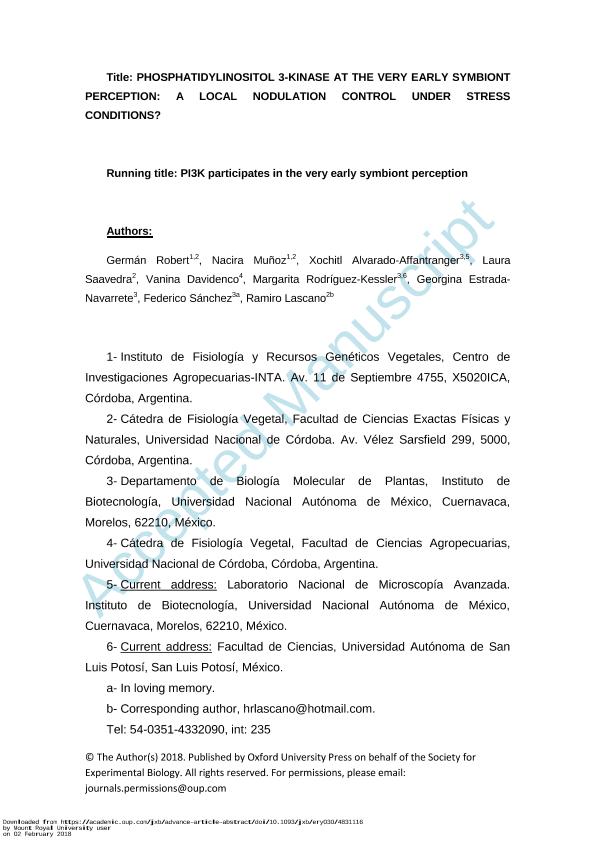Mostrar el registro sencillo del ítem
dc.contributor.author
Robert, Germán

dc.contributor.author
Muñoz, Nacira Belén

dc.contributor.author
Alvarado Affantranger, Xochitl
dc.contributor.author
Saavedra, Laura
dc.contributor.author
Davidenco, Vanina

dc.contributor.author
Rodríguez y Domínguez Kessler, Margarita

dc.contributor.author
Estrada Navarrete, Georgina
dc.contributor.author
Sanchez, Federico

dc.contributor.author
Lascano, Hernan Ramiro

dc.date.available
2021-06-07T14:24:03Z
dc.date.issued
2018-04-03
dc.identifier.citation
Robert, Germán; Muñoz, Nacira Belén; Alvarado Affantranger, Xochitl; Saavedra, Laura; Davidenco, Vanina; et al.; Phosphatidylinositol 3-kinase function at very early symbiont perception: A local nodulation control under stress conditions?; Oxford University Press; Journal of Experimental Botany; 69; 8; 3-4-2018; 2037-2048
dc.identifier.issn
0022-0957
dc.identifier.uri
http://hdl.handle.net/11336/133329
dc.description.abstract
Root hair curling is an early and essential morphological change required for the success of the symbiotic interaction between legumes and rhizobia. At this stage rhizobia grow as an infection thread within root hairs and are internalized into the plant cells by endocytosis, where the PI3K enzyme plays important roles. Previous observations show that stress conditions affect early stages of the symbiotic interaction, from 2 to 30 min post-inoculation, which we term as very early host responses, and affect symbiosis establishment. Herein, we demonstrated the relevance of the very early host responses for the symbiotic interaction. PI3K and the NADPH oxidase complex are found to have key roles in the microsymbiont recognition response, modulating the apoplastic and intracellular/endosomal ROS induction in root hairs. Interestingly, compared with soybean mutant plants that do not perceive the symbiont, we demonstrated that the very early symbiont perception under sublethal saline stress conditions induced root hair death. Together, these results highlight not only the importance of the very early host-responses on later stages of the symbiont interaction, but also suggest that they act as a mechanism for local control of nodulation capacity, prior to the abortion of the infection thread, preventing the allocation of resources/energy for nodule formation under unfavorable environmental conditions.
dc.format
application/pdf
dc.language.iso
eng
dc.publisher
Oxford University Press

dc.rights
info:eu-repo/semantics/openAccess
dc.rights.uri
https://creativecommons.org/licenses/by-nc-sa/2.5/ar/
dc.subject
ABIOTIC STRESS
dc.subject
NODULATION
dc.subject
PHOSPHATIDYLINOSITOL 3-KINASE
dc.subject
PI3K
dc.subject
REACTIVE OXYGEN SPECIES
dc.subject
ROS
dc.subject
SYMBIONT PERCEPTION
dc.subject
SYMBIOTIC INTERACTION
dc.subject.classification
Otras Biotecnología Agropecuaria

dc.subject.classification
Biotecnología Agropecuaria

dc.subject.classification
CIENCIAS AGRÍCOLAS

dc.title
Phosphatidylinositol 3-kinase function at very early symbiont perception: A local nodulation control under stress conditions?
dc.type
info:eu-repo/semantics/article
dc.type
info:ar-repo/semantics/artículo
dc.type
info:eu-repo/semantics/publishedVersion
dc.date.updated
2021-06-02T12:14:28Z
dc.journal.volume
69
dc.journal.number
8
dc.journal.pagination
2037-2048
dc.journal.pais
Reino Unido

dc.journal.ciudad
Oxford
dc.description.fil
Fil: Robert, Germán. Instituto Nacional de Tecnología Agropecuaria. Centro de Investigaciones Agropecuarias. Instituto de Fisiología y Recursos Genéticos Vegetales; Argentina. Universidad Nacional de Córdoba. Facultad de Ciencias Agropecuarias. Cátedra de Fisiología Vegetal; Argentina
dc.description.fil
Fil: Muñoz, Nacira Belén. Instituto Nacional de Tecnología Agropecuaria. Centro de Investigaciones Agropecuarias. Instituto de Fisiología y Recursos Genéticos Vegetales; Argentina. Universidad Nacional de Córdoba. Facultad de Ciencias Agropecuarias. Cátedra de Fisiología Vegetal; Argentina. Consejo Nacional de Investigaciones Científicas y Técnicas. Centro Científico Tecnológico Conicet - Córdoba; Argentina
dc.description.fil
Fil: Alvarado Affantranger, Xochitl. Universidad Nacional Autónoma de México. Instituto de Biotecnología; México
dc.description.fil
Fil: Saavedra, Laura. Universidad Nacional de Córdoba. Facultad de Ciencias Agropecuarias. Cátedra de Fisiología Vegetal; Argentina
dc.description.fil
Fil: Davidenco, Vanina. Universidad Nacional de Córdoba. Facultad de Ciencias Agropecuarias. Cátedra de Fisiología Vegetal; Argentina. Consejo Nacional de Investigaciones Científicas y Técnicas. Centro Científico Tecnológico Conicet - Córdoba; Argentina
dc.description.fil
Fil: Rodríguez y Domínguez Kessler, Margarita. Universidad Nacional Autónoma de México. Instituto de Biotecnología; México
dc.description.fil
Fil: Estrada Navarrete, Georgina. Universidad Nacional Autónoma de México. Instituto de Biotecnología; México
dc.description.fil
Fil: Sanchez, Federico. Universidad Nacional Autónoma de México. Instituto de Biotecnología; México
dc.description.fil
Fil: Lascano, Hernan Ramiro. Universidad Nacional de Córdoba. Facultad de Ciencias Agropecuarias. Cátedra de Fisiología Vegetal; Argentina. Consejo Nacional de Investigaciones Científicas y Técnicas. Centro Científico Tecnológico Conicet - Córdoba; Argentina
dc.journal.title
Journal of Experimental Botany

dc.relation.alternativeid
info:eu-repo/semantics/altIdentifier/url/https://academic.oup.com/jxb/article/69/8/2037/4831116
dc.relation.alternativeid
info:eu-repo/semantics/altIdentifier/doi/https://doi.org/10.1093/jxb/ery030
Archivos asociados
